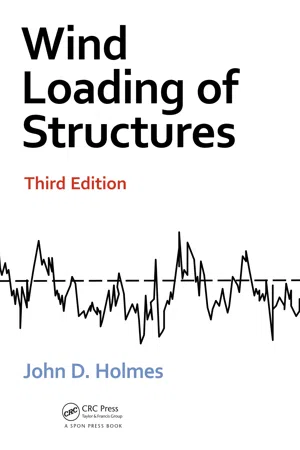
- 450 pages
- English
- PDF
- Available on iOS & Android
Wind Loading of Structures
About This Book
A Definitive Up-to-Date Reference
Wind forces from various types of extreme wind events continue to generate ever-increasing damage to buildings and other structures. Wind Loading of Structures, Third Edition fills an important gap as an information source for practicing and academic engineers alike, explaining the principles of wind loads on structures, including the relevant aspects of meteorology, bluff-body aerodynamics, probability and statistics, and structural dynamics.
Written in Line with International Standards
Among the unique features of the book are its broad view of the major international codes and standards, and information on the extreme wind climates of a large number of countries of the world. It is directed towards practicing (particularly structural) engineers, and academics and graduate students.
The main changes from the earlier editions are:
- Discussion of potential global warming effects on extreme events
- More discussion of tornados and tornado-generated damage
- A rational approach to gust durations for structural design
- Expanded considerations of wind-induced fatigue damage
- Consideration of aeolian vibrations of suspended transmission lines
- Expansion of the sections on the cross-wind response of tall slender structures
- Simplified approaches to wind loads on "porous" industrial, mining, and oil/gas structures
- A more general discussion of formats in wind codes and standards
-
Not dedicated to a specific code or standard, Wind Loading of Structures, Third Edition highlights the general format and procedures related to all major codes and standards, addresses structures of various types, and presents you with topics not typically covered in traditional texts such as internal pressures, fatigue damage by wind forces, and equivalent static wind load distributions.
Frequently asked questions
Information
Table of contents
- Front Cover
- Contents
- Preface to the first edition
- Preface to the second edition
- Preface to the third edition
- Author
- Chapter 1: The nature of wind storms and wind-induced damage
- Chapter 2: Prediction of design wind speeds and structural safety
- Chapter 3: Strong wind characteristics and turbulence
- Chapter 4: Basic bluff-body aerodynamics
- Chapter 5: Resonant dynamic response and effective static load distributions
- Chapter 6: Internal pressures
- Chapter 7: Laboratory simulation of strong winds and wind loads
- Chapter 8: Low-rise buildings
- Chapter 9: Tall buildings
- Chapter 10: Large roofs and sports stadiums
- Chapter 11: Towers, chimneys and masts
- Chapter 12: Bridges
- Chapter 13: Transmission lines
- Chapter 14: Other structures
- Chapter 15: Wind-loading codes and standards
- Appendix A: Terminology
- Appendix B: List of symbols
- Appendix C: Probability distributions relevant to wind engineering
- Appendix D: Extreme wind climates – A world survey
- Appendix E: Some approximate formulas for structural natural frequencies
- Appendix F: Example of application of the LRC method for the effective static wind loads on a simple structure
- Back Cover